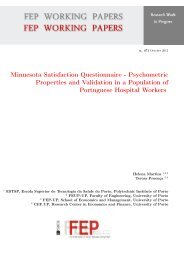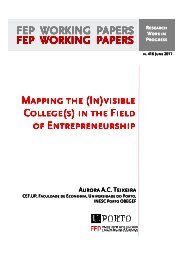FEP - Working Papers - Universidade do Porto
FEP - Working Papers - Universidade do Porto
FEP - Working Papers - Universidade do Porto
You also want an ePaper? Increase the reach of your titles
YUMPU automatically turns print PDFs into web optimized ePapers that Google loves.
4.2 Consumers’ surplus<br />
From the point of view of consumers, competition between department stores is the most<br />
favorable scenario. Prices are lower than in the other scenarios, and transportation costs<br />
are minimized. It is not so straigtforward to compare the case of competition between<br />
two shopping malls (lower transportation costs) with the case of competition between a<br />
shopping mall and a department store (lower prices).<br />
The total consumers’ surplus is given by: 12<br />
CS = ˜x (V − PL) + (1 − ˜x) (V − PR) −<br />
where V = � n<br />
i=1 Vi.<br />
� ˜x<br />
0<br />
tx dx −<br />
� 1<br />
˜x<br />
t (1 − x) dx,<br />
Let CSDD, CSMM and CSDM denote the consumers’ surplus in the three different<br />
scenarios: (DD) competition between two department stores; (MM) competition between<br />
two shopping malls; and (DM) competition between a department store and a shopping<br />
mall.<br />
Recall that when the mode of retail is the same in both extremes of the city, the price<br />
of the basket of goods is equal at both extremes. As a result, the indifferent consumer is<br />
located at the middle of the city and the total transportation cost is minimized. When<br />
there are two department stores, the price of the basket is t. When there are two shopping<br />
malls, the basket costs nt. Consequently:<br />
and<br />
CSDD = 1<br />
� 1<br />
1<br />
2<br />
(V − t) + (V − t) − t x dx − t<br />
2 2 0<br />
CSMM = 1<br />
� 1<br />
1<br />
2<br />
(V − nt) + (V − nt) − t x dx − t<br />
2 2 0<br />
� 1<br />
1<br />
2<br />
� 1<br />
1<br />
2<br />
(1 − x) dx = V − 5<br />
4 t<br />
(1 − x) dx = V −<br />
�<br />
n + 1<br />
�<br />
t.<br />
4<br />
12 Recall that the “one stop shopping” condition holds. Then, consumers located at [0, ˜x[ purchase all<br />
goods at x = 0, while consumers located at ]˜x, 1] make all purchases at x = 1.<br />
17











